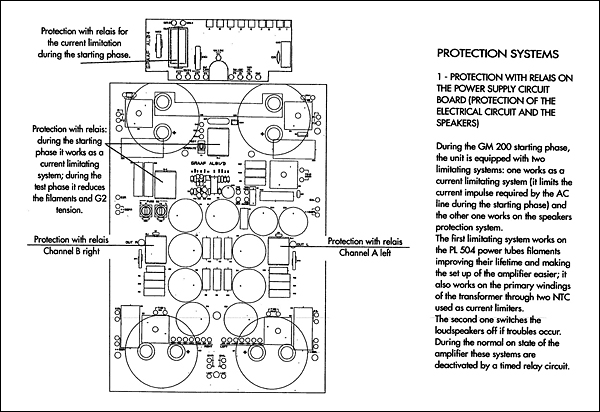A Rising GRAFF Page 2
Hot Pot
To drive the GM 200, GRAAF supplied one of its two line-level preamps, the GM 13.5B, each model selling for £3200. The one not supplied is the single-ended version, which sports a superior resistor ladder volume control. The GM 13.5B is the fully-balanced version and it contains a more compact but top-of-the-line ALPS pot because the other wouldn't fit. I was told that a future model will incorporate both balanced operation and the 'killer' volume control. What I was assured, though, (by GRAAF and by others) is that the balanced mode will contribute more to the overall performance than the better of the two volume controls, hence the 13.5B being the better-sounding of the two preamps.

Although I used the GRAAF pairing in fully-balanced mode with signals courtesy of the Krell MD-10/Reference 64 CD playing system in balanced output form, I did try the line inputs, too. And so good are they that I heard less difference between sources in single-ended vs balanced mode than I ever expected. Yes, the balanced input offered background 'silences' that were quieter, and a bit more in the way of transparency, but not so much that I was prepared to forget about that superior volume control in the other version. Also, because of a quirk with the sample I was reviewing, the volume control logic meant that I hit 'Way Loud' after less than a quarter of a turn. This too-hot volume control, I have been assured, is not typical, but I'm grateful to it for endowing me with a surgeon's delicate touch.
The GM 200 was connected to speakers ranging from Apogee Divas at one impedance extreme to LS3/5As at the other. In between were Sonus faber Extremas and Minima Amators, Linn Tukans, Wilson WATT/Puppies and Opera Callases. Why so much variety? I wanted to learn if here, at last, was an OTL for the real world, one which would work with something other than old Quad ESLs. And, with minor caveats, the GM 200 behaved like a monster solid-stater every time.
![]() Naked Truth
Naked Truth
Let's get the limitations out of the way first. I was told that if I insisted on using the GM 200 with Divas or Extremas, I'd be better off either bi-amping (tell that to the bank manager) or fitting the device which enables the smaller GM 100 to work with difficult loads and comes as standard with that unit. Suffice to say, I could use both the Divas and the Extremas at sane levels without complaint, but it didn't take too much to demonstrate the sound of clipping with those loudspeakers – oh, for a second amp!
With others, especially the WATT/Puppy package and the Minima Amator, the GRAAF GM 200 in solo emerged as what I can only describe as the best-sounding tube amp I've ever used. Yes, you can read that again. I said 'the best-sounding tube amp I've ever used'. Not the most accurate, not the most powerful or dynamic, but the nicest, sweetest, most comforting, most involving power amplifier I've tried.

It has sonic traits which keep the adjective 'perfect' in the dictionary and out of this review, but they're the kind that are so obvious and so understandable that you'll quickly decide to be pro or anti. Very simply, they are the sins of tube-ness, and if you don't like excess warmth, lushness and a bit of boom in the lower registers, then you'll look elsewhere. Hell, if you don't like warmth and lushness then you probably don't like any tube amps, let alone one which is all-tube and directly coupled to your speakers.
The GM 200 is 3D, it's open and it's transparent. There's a sense of clarity and of immediacy which I can only think of in terms of the debate in favour of 78s over later forms of sound storage: less between you and the music. To dig wa-a-ay back into the pre-politically-correct hi-fi reviewer's thesaurus, there's veil removal akin to a full striptease. This is naked sound, the tube artefacts not getting in the way of the resolution of fine detail or the sense of space. Even with poorly recorded discs, such as the recent live Marvin Gaye set on Magnum, the GRAAF amps managed to salvage a convincing sensation of space. Which is impossible, right?
Pop Idol
We all know that hi-fi can't add what's missing. So it can only mean one thing: the GRAAF electronics are letting more through. Admittedly, 'more' includes the tube traits mentioned above, but the overall sensation was one of going from a 27in screen to a Barco projector, from plastic eyeglass lenses to glass, from anything to a Leica. Or, since we're talking son and not lumière, it's like popping your ears as the aeroplane descends.

Great Expectations
As befits products from the country that rules in matters operatic, the GRAAF amp handles vocals like a cup of lemon-and-honey-spiked tea. Rasp, sibilance and chestiness, if present, will be byproducts of the speakers, not the electronics. As midband performers, the GRAAF siblings join such greats as Quad ESLs, Koetsu cartridges and, yes, LS3/5As. The extreme treble, unlike the bass, hasn't been excessively 'tube-ified', in that it is neither soft nor absent. So there's crispness and speed at one end and a lush tush at the other. In between is a mid-section that's positively fluid and smooth, the transitions from bread to filling barely perceptible.
I know I've just described as magnificent what an objectivist would adjudge a dog's dinner. But maybe words aren't enough. Listening to the GRAAF components – despite the high-tech-meets-vintage, steam-punk concept – is, as with Sonus faber's Guarneri, an emotional experience no matter how analytical you try to be. That this stuff makes me forget that I'm reviewing (working) is all I need to accept it as the perfect amp for me. Oops... there's the 'P' word.
























































